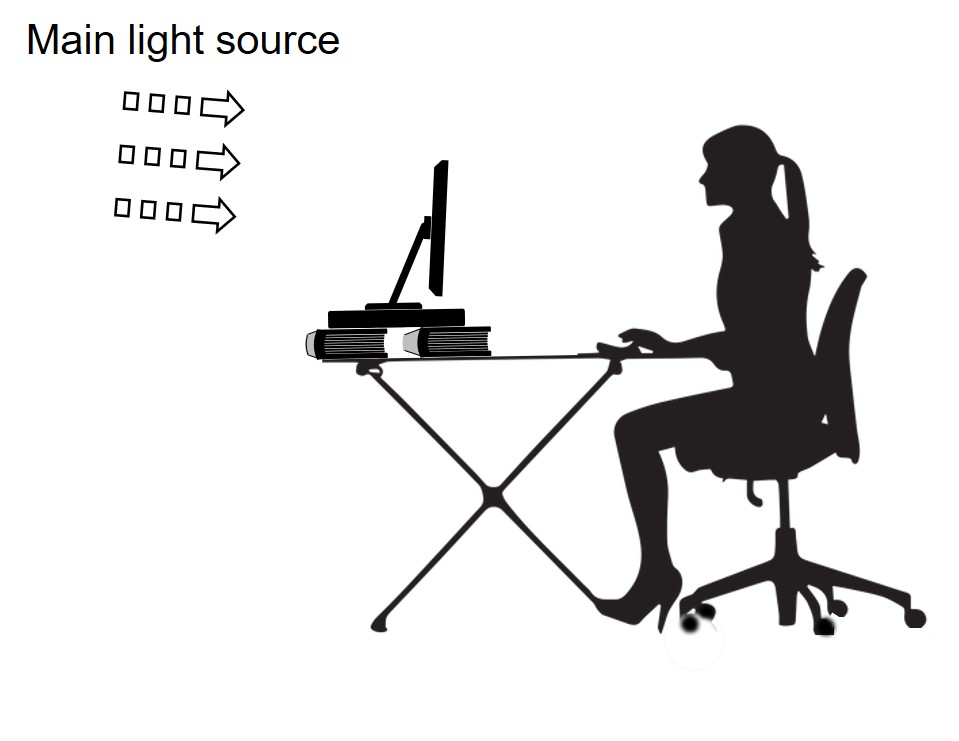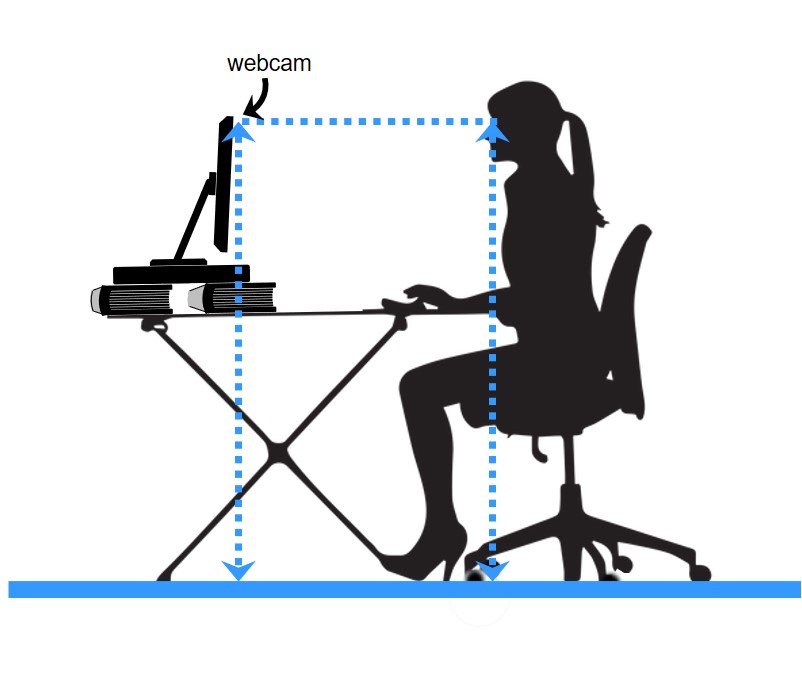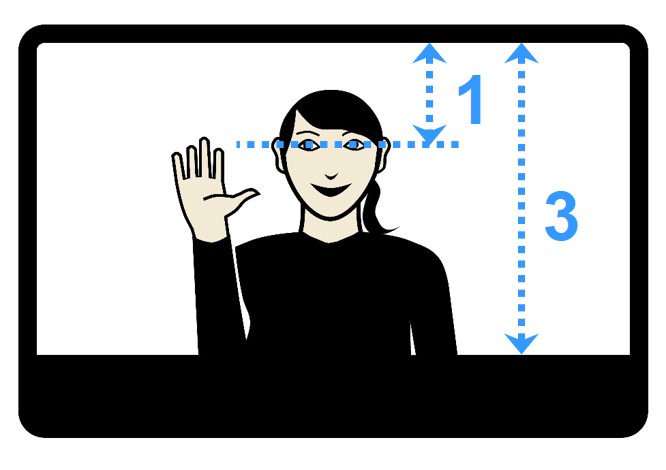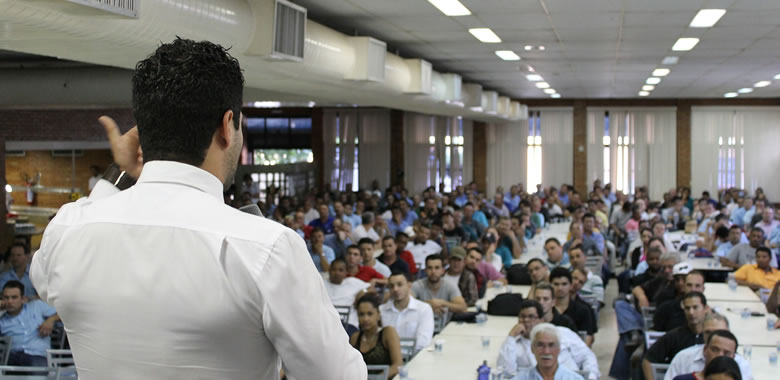Skillset New Zealand Blog
- Written by Michael Brown
Like it or not, online video meetings are a new reality. And, of course, we've all noticed that many people have no idea how to appear on the screen. We've all been subjected to the nostril view, the head-in-the-bottom-left view, and the mafia-silhouette view and other visual horrors.
Instead, let's pay attention to our screen presence, so that everyone else at our video meetings see us as fully present and engaged. Here are the basics of screen presence. (These basics assume that we're sitting.)
1. Orientation to the light
Put the main light source in front of you.
If your face still looks unevenly lit, add light from a table lamp to even it out. If you're next to a wall, you might bounce light off the wall onto the side of your face. Experiment until it looks right.

2. Web-cam height
Prop up your laptop until the built in web-cam is at the same height as your eyes.
You might have to measure both heights from the floor.
3. Eye and body placement on your screen
Tilt your screen until your image eyes are 1/3 of the way down the screen.
Now move forward or backward until only the upper half of your body shows on the screen.
4. Your body language
Mostly sit upright, or lean very slightly forward. The point is to show that you're paying attention to everyone else in the meeting.
5. Background
Glance at back at what's behind you. Is there anything so visually demanding that it would draw attention away from you? A minute's silence please for the on-line trainer whose partner wandered naked through the background looking for a towel.
6. Where do I look when I'm speaking?
Ignore the advice that says look at the web-cam - it's wrong. Instead put your gaze about 1/3 of the way down the screen. The technical setup means that each person in your meeting will feel that you're talking to them. (Incidentally, if it's a small group Zoom meeting in gallery view, you'll find that you're centering your gaze on an image of yourself. But don't worry, no one else will see that.)
And now, relax. When you're listening to the others, avoid major distracting movements, but small body movements are fine. When you're speaking, do use normal body, arms, hands and head movements to emphasize the point you're making.
One more point:
Enjoy your screen time. Who knows? There may be 15 minutes of fame in it.
- Written by Michael Brown

This is not about normal, interested inquiries. It's about the questions or interjections that come at you loaded with negative feelings. Loaded with emotion.
What does emotional loading mean in practice?
It comes in two different forms, often both together.
Emotion conveyed by tone. For example, imagine an audience member saying, "This is exactly what we did last time." Or "You mean three times a day?" Tone could make those words neutral, or it could load them with frustration or annoyance.
Emotion conveyed by words. For example, "My team will be annoyed about this." Or "The clients are going to be wary." Or "I'm sceptical about the changes." The emotional words are annoyed, wary, and sceptical
The challenge is to respond in a way that brings you respect, even from those who still disagree with your argument.
But first...
How not to handle a tough question or interjection
Don't get angry. If you show anger, annoyance, or even irritation, you've lost the game. You're not coping. You're not in control. The audience decides that you don't care how they feel.
Don't get defensive. By all means defend your position, but don't be defensive as you do it. Not clear? You're defensive if you show anxiety. Once again that says you're not coping.
Don't pretend that you didn't hear the emotion. This is a big one. It's like pretending that part of your audience isn't there. Many managers and executives fall into this trap by responding only to the face value of the words.
An example:
Interjector: (tone of frustration), "We've tried that procedure four times already."
Presenter: (fixed pleasant smile) "Actually it was three times. Now, about the scheduile..."
Bad response. The presenter might as well have issued a statement that says, I can't cope with the way you feel. Worse: if significant numbers of people in the audience also have the same frustration, the speaker's loss of credibility is huge. In fact the biggest emotion in the room may now be: You don't care how we feel, you don't understand where we're coming from. You can't relate to us so we can't relate to you.
Many managers talk themselves into this disastrous thinking: it's better to keep the emotions out of it, stick to the facts, then we can get things done. Wrong - we do not relate to each other by facts, logic, or rational thought. Emotions are at the centre of what it is to be human. Audiences know that instinctively, and swiftly lose respect for anyone who thinks otherwise.
Pretending not to hear the emotion = instant loss of credibility
Enough on what not to do. Now, how do we respond to this challenging thing we call emotion?
The right response generates credibility and respect
The answer is in two parts:
1. For the milder questions and interjections
As you answer, show - with your tone and body language - that you heard the feeling behind the words. That could be raised eyebrows, a slight pause, a nod, more animation, a slightly raised tone.
That shows you heard the feeling behind the words. It's subtle, it's strong, it connects. Audiences crave it in their speakers. Experienced, engaged presenters don't turn this skill on and off for questions and interjections, they never stop doing it. That's because they are permanently awake to and responding to subtle shifts in the vibes of the room.
2. When the emotions are strong and obvious
Verbally acknowledge the emotion, then reply.
Build your emotional vocabulary. Be ready to acknowledge emotion in others, using words like, "difficult", "frustrating", "sceptical", "annoying", even "angry". For example: "Yes, that must be frustrating..." "Sure. It won't be easy..." "If I thought that, I would be sceptical too..." "You have your doubts about this model? [Looks around.] And a few others feel the same way? Okay, I suggest..."
But isn't that being negative? If I do that, wouldn't I be undermining my own argument?
Not in the slightest (unless you're looking or sounding anxious). Acknowledging a negative emotion is not the same as agreeing with the negative argument. It's simply recognising that emotions are a natural part of your presentation, and of any gathering. And you are strong enough to fold them seamlessly and constructively into your presentation.
Accept the feelings, argue the facts.
In fact you will not positively persuade with your argument until you accept the current negative feelings about it. Try this example:
Interjector: (angry tones) "You can't be serious! How the hell are we going to keep up the payments?"
You: (warm, intense, animated) "Yes! That's the biggest concern for most of us... [looking around] ...agreed? Well I'm looking at two sources of..."
I'm saying Yes? To someone who is negative and angry at me?
That's right. The Yes! works because you're welcoming the negative feelings out into the open. You are essentially thanking that person for making the elephant visible. Now you can deal with the real world, which, of course, runs on feelings. This is top rate EQ (emotional intelligence), in a presentation context.
A last thought to ponder:
For top presenters, fully engaged with their audiences, there's no such thing as a negative emotion.
It takes courage, but you have everything to gain in personal authority and credibility
Christchurch
E-mail: info@skillset.co.nz
